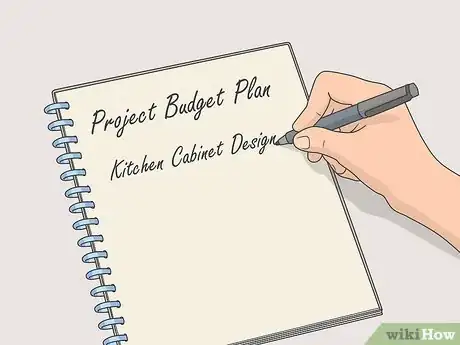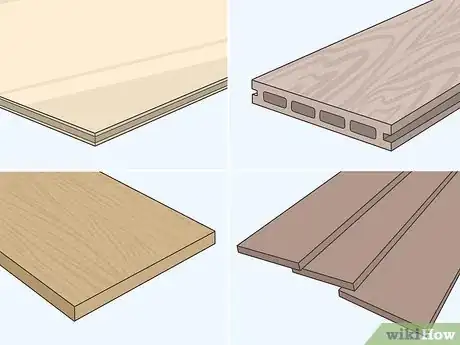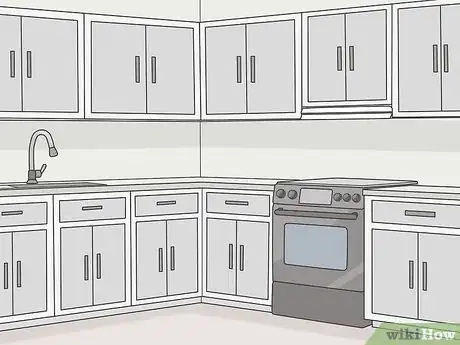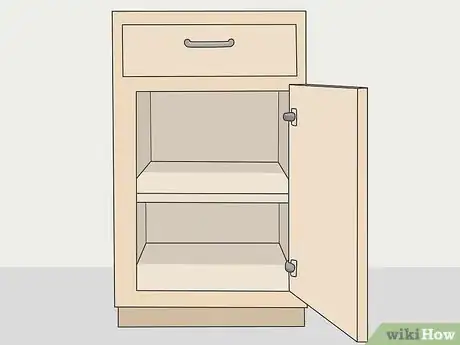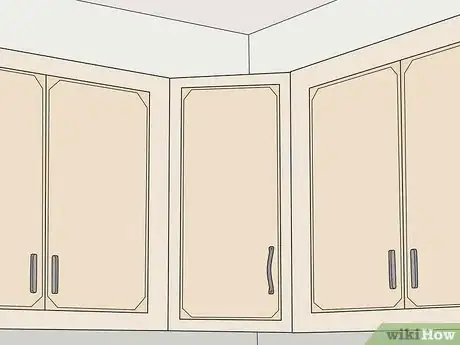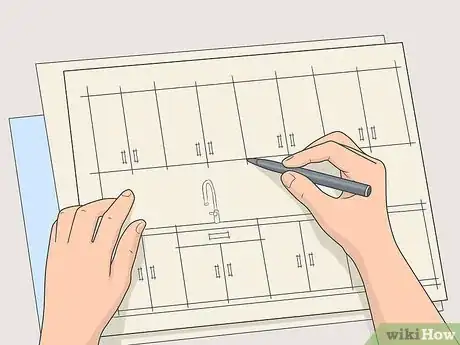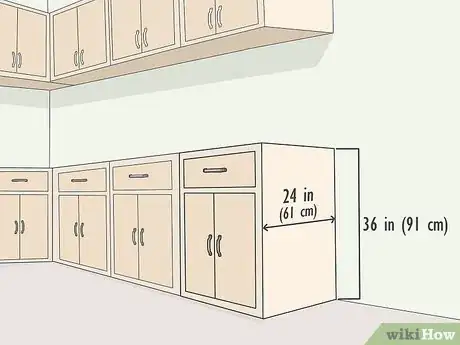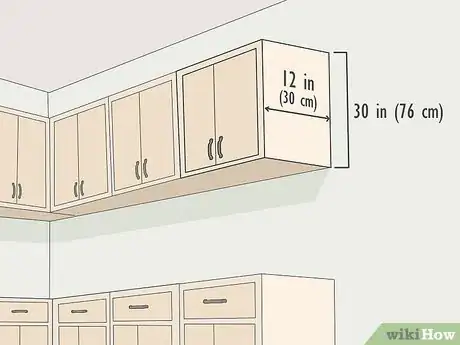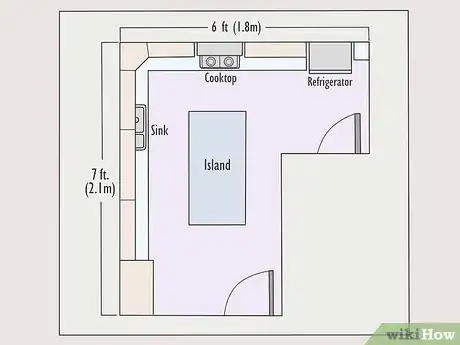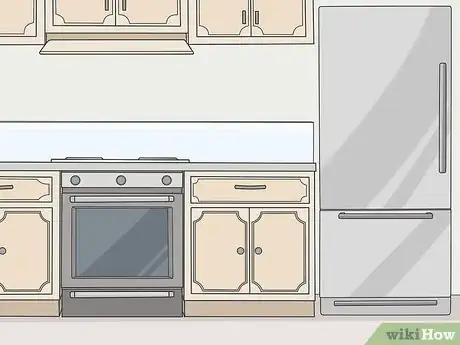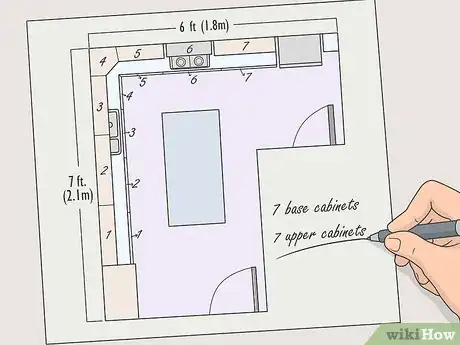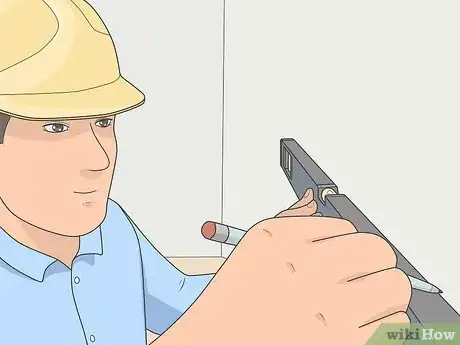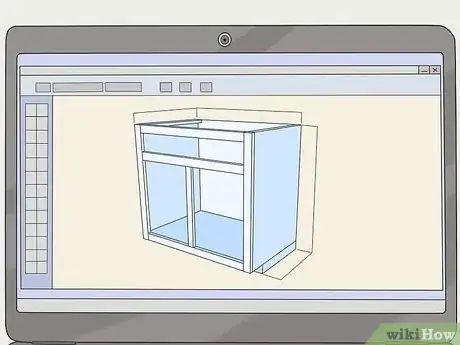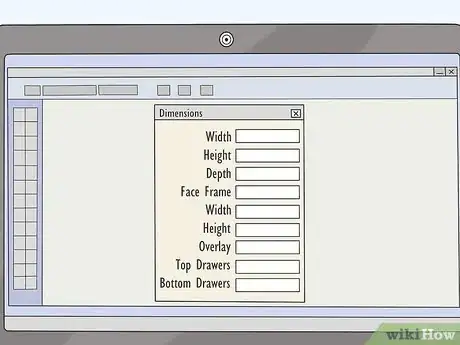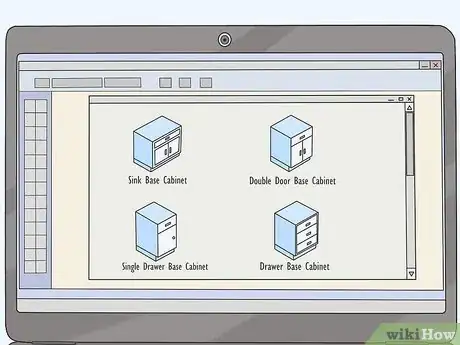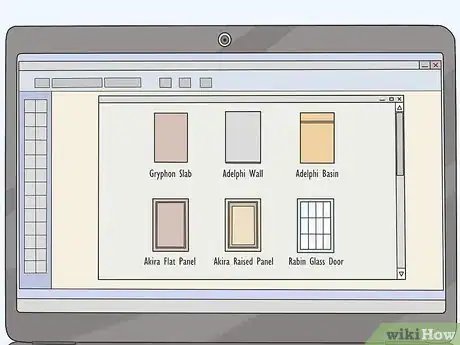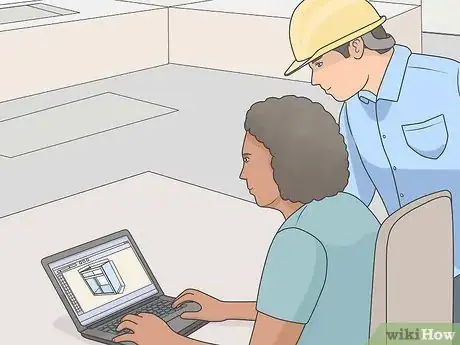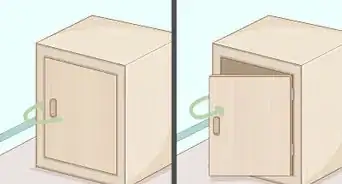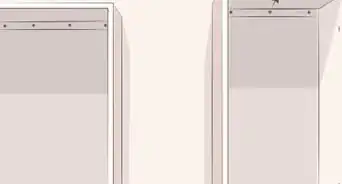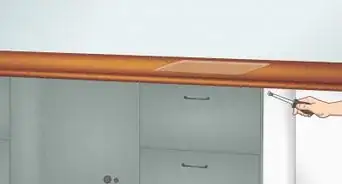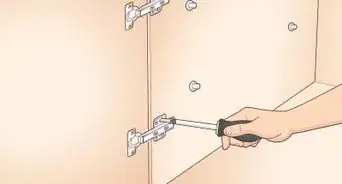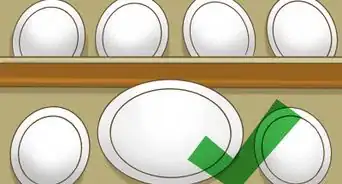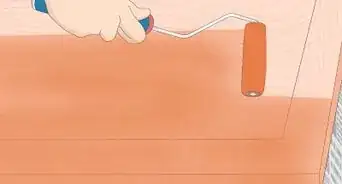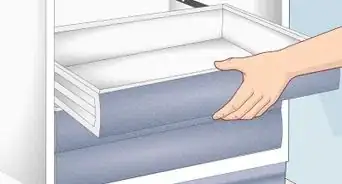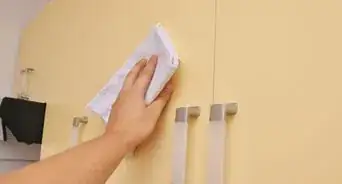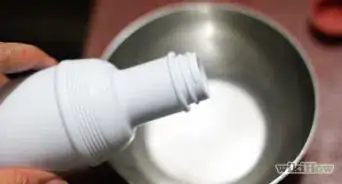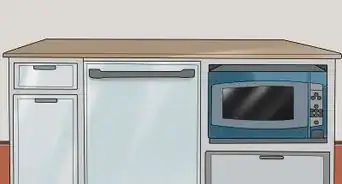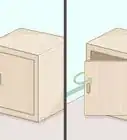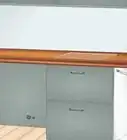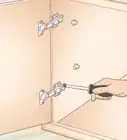This article was co-authored by MacKenzie Cain. MacKenzie Cain is an Interior Designer and a LEED-certified Green Associate for Habitar Design based in Chicago, Illinois. She has over seven years of experience in interior design and architectural design. She received a BA in Interior Design from Purdue University in 2013 and received her LEED Green Associate certification from the Green Building Certification Institute in 2013.
There are 13 references cited in this article, which can be found at the bottom of the page.
This article has been viewed 15,506 times.
Designing your own kitchen cabinets can add a unique, custom style to your home. First, think about the colors and materials you want to use. Match these designs to the overall style of your kitchen. Then measure your kitchen to create a detailed floor plan of the work space. Use this floor plan to determine how many cabinets you can fit in your kitchen. If you want to see how all of the options will look, use a design software for the job.
Steps
Choosing Designs and Colors
-
1Set a project budget to determine what you can afford. Kitchen construction jobs can be very expensive. The materials and labor for this work can add up fast. Have a budget in mind for the entire project. Use this as a guide for choosing materials and designs for the cabinets.[1]
- There is a big range for how much a kitchen cabinet job can cost. If you build and install them yourself, total costs can be $5,000-10,000, depending on how many cabinets you build and what sort of materials you use. With custom made and professionally installed cabinets, the job can reach $20,000 or more.
- Consider saving up ahead of time to prepare for the project rather than relying on credit cards or loans. In the long-term, you'll avoid spending more money from paying interest.
-
2Pick a construction material for the cabinets. You have several choices for what material you’ll use for your cabinets. All have different advantages and costs associated with them.[2]
- Plywood is the most common cabinet material. It is durable, affordable, and easy to work with. Plywood has a very plain color, though, so you’ll have to stain or paint the cabinets.
- Composite board is a cheaper option. It will save you a lot of money on materials, but won’t last as long as other options.
- Solid wood like oak, pine, or birch are common in cabinets as well. Solid wood tends to flex, however, so contractors don’t recommend it for humid environments. Solid wood is also more expensive than plywood.
- Wood substitutes like laminate can give you a natural wood look for a cheaper price. They are usually very durable. You usually can’t paint or stain laminate, so your options for customization are limited.
Advertisement -
3Match your cabinet color to the rest of your kitchen. Whether or not you’ll paint your cabinets, consider the rest of your kitchen when deciding on a color. Think about what type of mood and atmosphere you want in the kitchen. If you’re going for a more modern look, black cabinets with stainless steel appliances would work together. If you want a more rustic look, natural wood colors might be best. Take all this into account when picking out a material or paint color.[3]
- In small kitchen spaces, use brighter colors. Dark colors usually make rooms look smaller.
- Make sure the colors you’re planning don’t clash. If your countertop is black, lime green cabinets wouldn’t look good next to that.
- If the wood you chose isn’t exactly the right color, you can apply a stain to match the color to your kitchen better.
- Consider speaking with an interior designer for tips on coming up with a style for your cabinets.
-
4Decide if you want a face frame for the cabinets. A face frame is an outer border on the front of cabinets. It adds an extra design to your cabinets. If you want something more than just plain cabinet doors, a face frame can add style.[4]
- You can design face frames into whatever shapes you want. They can be as simple as cutting a few strips of wood to make a square border the cabinet door.
- More complicated face frames have shapes and designs. This takes a lot of woodworking skill, so speak with a professional if you’d like this kind of design.
- Remember that building a face frame requires more material, and will therefore cost more.
-
5Envision any irregularly-shaped cabinets you might use. At their most simple, cabinets are just boxes with doors and only require rudimentary skill to make. If you want more complicated or irregular designs, plan them out ahead of time. Think about how different angles might work in different corners of the room and how they would add to the room’s style.[5]
- Irregular cabinets are usually above stoves or other appliances because there is less room.
- Remember that if you have to fit a cabinet above your stove, it doesn’t need to have a difficult design. You could just make a smaller box.
-
6Speak to an interior designer if you don't know where to start. Interior designers are professionals who specialize in helping homeowners and businesses decorate spaces. If you know you want custom kitchen cabinets but don't know what will work in your kitchen, consider hiring a professional designer to help. They can show you all the options and make suggestions on what's best for you.[6]
- In the US, look for a designer certified by the Designer Society of America to know they are a professional.
- Ask for the price this designer will charge before hiring them. Avoid being surprised by a bill when the work is finished.
Measuring Your Kitchen Space
-
1Plan base cabinets that are 36 in (91 cm) tall and 24 in (61 cm) deep. This is the standard measurement for base cabinets because it’s the right height for an average adult to work at the counter without bending over or standing on their toes. Appliances like dishwashers are planned around this measurement as well so they reach the same height as the base cabinets.[7]
- This measurement is also helpful because an average sheet of plywood is 4 ft (1.2 m) x 8 ft (2.4 m). That means if you cut a piece of plywood in half widthwise, you have 2 cabinet sides of 24 in (61 cm). This reduces the amount of cutting you have to do.
-
2Design upper cabinets so they’re 12 in (30 cm) deep. This is a standard measurement for upper cabinets because they allow an average adult to work at the counter without the cabinets getting in the way. When taking measurements in your kitchen, plan on having upper cabinets that extend 12 in (30 cm) from the wall.[8]
- Upper cabinets are usually installed 18 in (46 cm) above the countertop.
- There is no universal measurement for how tall upper cabinets should be. Think about how much storage space you need and how much room you have under the ceiling to plan a height for the cabinets. 30 in (76 cm) is a common height.
-
3Draw a floorplan of your kitchen.[9] This floorplan shows you exactly how much room you have to install your cabinets. Start by measuring the total length, width, and height of your kitchen. Then measure around any appliances and subtract that number from your total available space.[10] Draw this floorplan out on a piece of graph paper.[11]
- For example, your kitchen wall may be 10 feet (3.0 m) long, but the refrigerator might be in the way and take up 3 feet (0.91 m). This means you have 7 feet (2.1 m) available for cabinets on that wall.
- Draw your floorplan to scale. If you use a piece of graph paper, use a guide like 1 box = 1 inch (2.5 cm). Keep this consistent so your floorplan is drawn to scale.
-
4Plan your cabinets around appliances and obstructions. With your measurements and floorplan done, start planning how you’ll position cabinets around any appliances. Design your cabinets so no appliances are in the way and you can open the doors or drawers without any obstructions stopping you.[12]
- For example, you can’t install base cabinets where your dishwasher is, so break this area into 2 subsections around the dishwasher. Measure the available space on each side of the dishwasher, then plan how many cabinets will fit in each subsection.
- Also account for the doors and drawers in cabinets when they’re open. Don’t plan for a cabinet that can’t open its door because an appliance is in the way.
-
5Calculate how many cabinets you can fit in your available space. After taking all the necessary measurements, determine the total number of cabinets you'll need. Add up the dimensions of your cabinets and divide that into your available wall and floor space to get a result on how many cabinets you can fit in your kitchen.[13]
- Calculate the wall and floor space separately. This way you can plan both the base and upper cabinets.
- For example, if you have 7 feet (2.1 m) of available floorspace for base cabinets in one area and are planning 24 in (61 cm) cabinets, that means you can fit 3 cabinets in this space. Do the same calculation for each area in your kitchen.
- Come to a total cabinet count to determine how much material you'll need for the project.
-
6Have a contractor measure your kitchen if you don't feel confident. If you don't think you can accurately measure your kitchen yourself, bring in a contractor to help. They will sketch a floor plan, take all the necessary measurements, and calculate how many cabinets you can build. This ensures that all the measurements are accurate.
- If you like the contractor, you can even hire them to do the whole job.
- Contractors often work with interior designers as well. This team can produce custom made cabinets just for you if you want them to.
Using Software to Design Your Cabinets
-
1Find a program that allows you to design cabinets. There are new software programs that let contractors produce digital sketches of designs before building anything.[14] These programs can help you envision the project you're planning and make changes more accurately.[15]
- There are several design programs on the market, so do some investigating to find the right one for you. Look for a program that is especially good for kitchen cabinet design.
- Some design software is free and some is paid. Consider spending some money on a better program for more accurate results.
- Some software offers a free trial period before you have to purchase it. If possible, try to design your cabinets during this trial period.
-
2Plug your kitchen dimensions and design into the software. All programs work in their own way, but almost all will ask for your kitchen dimensions and current layout. [16]
- Include as much detail as you can in this readout. Try to re-create your kitchen digitally. This way, you can easily imagine how the sample cabinets you see will look in your kitchen for real.
-
3Pick a style for your cabinets from the list of options. Once your kitchen layout is plugged in, the software gives you an option for what style you want for your cabinets. You have a huge number of choices. If you have an idea of what you want, type in the wood, style, color, and size you have in mind. Otherwise, scroll through the options and see what looks good in your kitchen.[17]
- Consider how much storage space you need. Tall wall cabinets might look nice, but if you have nothing to put in them then this is a big expense for something that you won't use.
- Look at the different designs that the program offers.
-
4Scroll through different material and color choices for your cabinets. After picking a style for your cabinets, move on to the options for color and materials. See which colors work with your kitchen space and which ones clash. Then decide what materials you'd like to use.[18]
- Remember the relative advantages and disadvantages of different materials. The software may not warn you that solid wood tends to flex in humid environments, for example.
-
5Save your design and show it to a contractor to have it made.[19] When you settle on a design you like, contact a contractor to consult them about building the cabinets. Bring the design with you and ask if they can complete the job for you.[20]
- Some software gives you a price quote on the project you designed. Use this option before speaking to a contractor for an idea of what this job will cost. Otherwise, ask the contractor for a quote before hiring them.
- Some software also recommends contractors near you. Use this tool if you don't know where to start.
Expert Q&A
Did you know you can get expert answers for this article?
Unlock expert answers by supporting wikiHow
-
QuestionHow do I design a new kitchen layout?
 MacKenzie CainMacKenzie Cain is an Interior Designer and a LEED-certified Green Associate for Habitar Design based in Chicago, Illinois. She has over seven years of experience in interior design and architectural design. She received a BA in Interior Design from Purdue University in 2013 and received her LEED Green Associate certification from the Green Building Certification Institute in 2013.
MacKenzie CainMacKenzie Cain is an Interior Designer and a LEED-certified Green Associate for Habitar Design based in Chicago, Illinois. She has over seven years of experience in interior design and architectural design. She received a BA in Interior Design from Purdue University in 2013 and received her LEED Green Associate certification from the Green Building Certification Institute in 2013.
Interior Designer & LEED Green Associate With the internet and social media, we really have access to endless amounts of information. You can source examples of new designs and material information from many places. One of the easiest and most user-friendly sites is houzz.com, especially if you are just getting started. If you need guidance and inspiration, you can find thousands of homes, design and construction firms, and even materials and fixtures online. Simply search for kitchens, bathrooms, fireplaces, etc. and create an idea book for your own home. You can use these methods to hone in on your desired aesthetic as well.
With the internet and social media, we really have access to endless amounts of information. You can source examples of new designs and material information from many places. One of the easiest and most user-friendly sites is houzz.com, especially if you are just getting started. If you need guidance and inspiration, you can find thousands of homes, design and construction firms, and even materials and fixtures online. Simply search for kitchens, bathrooms, fireplaces, etc. and create an idea book for your own home. You can use these methods to hone in on your desired aesthetic as well. -
QuestionWhat goes in a kitchen floor plan?
 MacKenzie CainMacKenzie Cain is an Interior Designer and a LEED-certified Green Associate for Habitar Design based in Chicago, Illinois. She has over seven years of experience in interior design and architectural design. She received a BA in Interior Design from Purdue University in 2013 and received her LEED Green Associate certification from the Green Building Certification Institute in 2013.
MacKenzie CainMacKenzie Cain is an Interior Designer and a LEED-certified Green Associate for Habitar Design based in Chicago, Illinois. She has over seven years of experience in interior design and architectural design. She received a BA in Interior Design from Purdue University in 2013 and received her LEED Green Associate certification from the Green Building Certification Institute in 2013.
Interior Designer & LEED Green Associate
References
- ↑ https://www.bhg.com/kitchen/cabinets/styles/kitchen-cabinet-costs/
- ↑ https://www.bhg.com/kitchen/cabinets/styles/kitchen-cabinet-material-types/
- ↑ https://youtu.be/AzRdAXo2xpM?t=382
- ↑ https://youtu.be/AzRdAXo2xpM?t=221
- ↑ https://www.woodmagazine.com/make-cabinets-the-easy-way
- ↑ https://www.dsasociety.org/resources/choosing-a-designer/
- ↑ https://youtu.be/AzRdAXo2xpM?t=74
- ↑ https://youtu.be/AzRdAXo2xpM?t=201
- ↑ MacKenzie Cain. Home Design Specialist. Expert Interview. 7 April 2020.
- ↑ MacKenzie Cain. Home Design Specialist. Expert Interview. 7 April 2020.
- ↑ https://www.lowes.com/n/how-to/measure-your-kitchen
- ↑ https://www.diynetwork.com/how-to/skills-and-know-how/carpentry-and-woodworking/how-to-build-a-wall-cabinet
- ↑ https://www.lowes.com/n/how-to/measure-your-kitchen
- ↑ MacKenzie Cain. Home Design Specialist. Expert Interview. 7 April 2020.
- ↑ https://www.woodworkersjournal.com/best-software-program-buildin-cabinets/
- ↑ https://designingidea.com/kitchen-cabinet-design-software/
- ↑ https://www.woodworkersjournal.com/best-software-program-buildin-cabinets/
- ↑ https://www.woodworkersjournal.com/best-software-program-buildin-cabinets/
- ↑ MacKenzie Cain. Home Design Specialist. Expert Interview. 7 April 2020.
- ↑ https://www.woodworkersjournal.com/best-software-program-buildin-cabinets/
